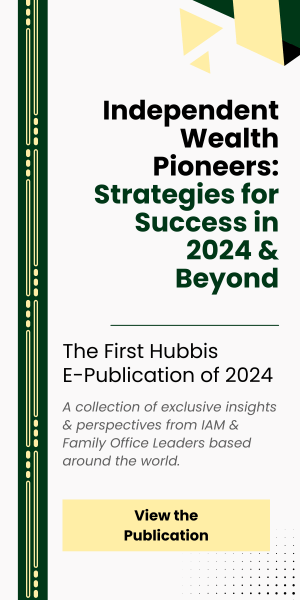Publications & Thought Leadership
Fixed Income & Credit – Opportunities and Challenges for the Year Ahead

Feb 8, 2023
As we turn the page into 2023, many investors are still reeling from the speed and scale of rate hikes across the developed world in 2022. But with all that comes some positives, as coupons as well as spreads offer private clients yields that even in late 2021, they might not have imagined seeing for many years ahead and had not seen since before the global financial crisis. But now rates are much higher, how do private clients play the world of fixed income and credit? This Digital Dialogue – exclusively supported by Allspring Global Investments - concentrated on the search by private clients for risk-managed yield across the world of fixed income and credit, as some sort of rates normalisation trends closer and as recession fears continue to weaken the outlook for equities.
A Hubbis Digital Dialogue Event on 12th January 2023
Exclusive Sponsor: Allspring Global Investments
The Panel:
- Henrietta Pacquement, Senior Portfolio Manager and Head of The Global Fixed Income, Allspring Global Investments
- Paul Gambles, Director, MBMG Group
- Gareth Nicholson, Chief Investment Officer and Head of Discretionary Portfolio Management, International Wealth Management, Nomura
- Abhilash Narayan, Senior Investment Strategist, Group Wealth Management, Standard Chartered Bank
Setting the Scene
Our panel of experts analysed where interest rates are heading, where there is the best alignment of returns, stability and liquidity, and how private clients should approach the opportunities that might lie ahead, such as allocating more to government bonds, to DPM mandates, investing more through active funds, and so forth. And they discussed where the world of ESG aligns neatly with these fixed income strategies and approaches to tick more of the boxes that investors want to pursue today so that the search for yield, security and liquidity is also a search for transparency and sustainability.
The panel discussed which regions, which countries, and which segments might be the most appealing in 2023, and why, whether there should be largely an increased allocation to sovereign debt, or to credit, to subordinated paper, to corporate high yield, or to all of those. They scrutinised how wealthy private investors should slice and dice their fixed income portfolios, for example, whether they align with the indices or whether as private clients they are better off pursuing an entirely different portfolio curation to the global institutional investor community, which of course is driven more by indexing, weightings and benchmarks.
Underling all their prognostications, the panel painted a picture of the backdrop of economic momentum, or the lack of it, rising (and potentially sustained) inflation, the ongoing winding back of the G7 QE tsunami towards ‘normalisation’, and how different regions of the world are likely to react.
The Hubbis Post-Event Survey on Fixed Income and the Private Investor in Asia
Roughly what percentage of your HNW and UHNW clients’ total financial investment portfolios today are now allocated to debt/fixed income?
More than 75% 3%
50-75% 26%
25-50% 40%
Less than 25% 31%
And by the end of 2023, what percentage of your HNW and UHNW clients’ total financial investment portfolios do you predict should be allocated to debt/fixed income?
More than 75% 6%
50-75% 43%
25-50% 41%
Less than 25% 10%
In fixed income, what percentage allocation for HNW and UHNW investors would you advise currently to the following?
Developed markets 65%
Emerging Markets 35%
What percentage allocation for HNW and UHNW investors would you advise currently to each of these segments?
Sovereign 30%
Medium to higher-rated credit 35%
High Yield/Lower rated paper 17%
Subordinated paper of investment grade credits 18%
How would you advise HNW and UHNW investors to allocate their fixed income/debt investments geographically?
US/North America 38%
Europe 17%
Asia Pacific 35%
LatAM/Middle East/Other EM 10%
What percentage allocation should HNW and UHNW investors adopt for their fixed income portfolios?
Publicly traded paper 50%
Private fixed income/debt 15%
Direct purchases/individual bonds 35%
How would you advise HNW and UHNW investors to build their fixed income portfolios?
Actively managed fixed income funds 58%
Passives/ETFs 42%
Describe what role leverage should play in Asia’s HNW and UHNW fixed income portfolios in the current and anticipated environment ahead?
Clients should leverage up, the returns will be great 2%
Clients can use leverage, but carefully and cautiously 49%
With much higher and potentially rising rates, take an extremely cautious approach 49%
How important are structured products to help boost yield/income these days?
Extremely useful 4%
Still of interest 53%
Less useful than before 28%
To be avoided 15%
Finally, are you strong advocates of the Chinese fixed income markets?
Absolutely, there are tremendous opportunities 11%
We are gradually encouraging investors to build exposures there 24%
China’s credit markets should be approached cautiously 60%
Avoid at all costs 5%
The Bond Markets Speak - Rumours of their Demise are Much Exaggerated
“Bonds are back!” stated one expert on opening the dialogue. “Over the last few years, excluding 2022, bonds were offering very low yields, and risk return characteristics were not very attractive across asset classes. 2022 was the climax when we saw a serious change in monetary policy, a seismic shift from global easing to tightening and that was really felt the hardest in the investment grade space, where the return relative to the volatility was just really difficult. But it has resulted in a much better starting point now, with attractive yields in deposits, and on short and longer dated paper.”
And he said that as they see the curve flattening, they are aiming to add a little bit more duration. “Additionally,” he said, “we believe later in the year when more of the recession is priced in and there is a bit more spread widening, high yield is going to become again attractive. So, bonds are back and we're quite excited.”
“There is huge pent-up demand in Asia, for example for travel from China,” said one speaker. “But the pent-up demand is going to push up inflation, which will drive more demand for commodities. A lot more tourists are going to be traveling around the world, a lot more money spent. Inflation will likely be higher than comfortable for some time.”
Another speaker said that the inflation story was not likely to last so long, and that it had helped the US Federal Reserve normalise rates, as it had wanted to do for some years.
“Inflation has been a great cover story as the Fed wanted rates back above 5% since 2012, so that when they cut them when required,” he reported. “That is their version of normal, assuming historical exceptions are anomalies, so we see inflation really just as an excuse.”
But an expert said he felt that it is overall a great time to just enter bonds and lock in the yields from most of the asset classes across the fixed income market. “Sovereigns, DM credit, EM credit, all of them are close to the highest level you've seen in 10 years.”
Fixed income is again looking appealing for private investors, and Asia’s IG dollar paper beckons
“I do not recall any time in the past eight plus years since I took my current role when we had such a strong conviction on fixed income,” proclaimed another expert. “We do have a preference for high quality bonds, such as investment grade corporates, specifically across developed markets, but specifically more so in Asia. Spreads in IG US paper have widened but not enough, they are not cheap, they have not risen the usual 200bp in more recessionary periods. Indeed, we are still some ways away from that.”
This, he said, means they think there is better value in Asian dollar bonds, including Chinese paper. “When we look at the spread differential between US and Asian corporate bonds in the IG space, we think that the spread pick-up in Asia is quite attractive.”
But he also added that Asian local currency sovereigns are offering around 150 basis points, a low yield as compared to what you can get in Dollar terms. “That is rare,” he told guests. “The last time it happened was about a decade back. So, we think that when you look at the higher yield that you are now getting in offshore markets, and the fact that you take additional currency volatility by going into local currency bonds, we think that the risk reward is sort of neutral as at best.” Meaning the local currency Asian debt is not yet pulling investors in wholesale.
“The 60/40 allocation model had died, but this year, I think it is going to be roaring back with a vengeance,” another speaker stated.
And another guest agreed but highlighted how investors need to be wary of FX volatility that could remain elevated in 2023, meaning they need to be paid enough in USD to offset the FX risk.
After a bruising 2022 for investments, this expert sees the glass at least half full in 2023, at least for higher quality fixed income and possible for sub-IG
An expert opened her commentary by reporting that a bruising 2022 has left fixed income markets in a much better place to start 2023. “We have now thankfully left negative rates behind us globally and income is back,” she states. “Investors no longer need to stretch down the credit spectrum or into less liquid assets to get yield to avoid the iceberg of negative yielding debt that at one stage peaked at USD18 trillion of paper.”
To illustrate the challenge in fixed income in recent years, she noted that investment grade credit hit a trough in yield of 1.7% in 2020, and worse still European investment grade dropped to 12bps of all in yield in 2021.
“What do you do as an insurance company with 12bp of yield? What do you do as pension fund with 12bps on yield?” she pondered. “Well, not a lot, and thankfully that is all behind us, and we are looking at over 5% in the USD and GBP investment grade credit and over 4% in EUR investment grade credit. With rather flat all-in yield curves as well. All in all, those are much healthier levels to start the year for investors.”
Many road bumps ahead
But she warned that it is not all plain sailing from here. She said that from a valuation perspective, the carry has certainly improved, which is positive for government bond investors, but rolldown is not great, reflecting the current curve inversion.
“Negative momentum in sovereign performance is abating though rates volatility remains elevated,” she observed. “From a fundamental perspective, inflation is still hot, even if it is trending in the right direction and growth signals are going south. That gives us overall a more neutral signal on rates at this point, but not a slam dunk either way as yet.”
Inflation – not yet reined in
On the inflation front, this same expert added that in the past there had been way too much stimulus, especially in the US, and then the Fed has been too slow to change course, meaning the drivers of inflation there are more self-inflicted. On the European side, she observed that inflation is more driven by commodity prices, and more dependent on geopolitical troubles in Eastern Europe, and therefore with Russia still waging war on the Ukraine, things remain more unclear as to the future.
Meanwhile, China reopening is going to bring a bit more competition, particularly on the commodity side, and she says it will be interesting to see if that is more of an inflation driver. “China is reopening and that is going to help on many of the supply chain issues that were so acute in 2022,” she said. “In reality, there are more push and pull forces on the inflation side begin to play out over the course of the year ahead.”
Pluses and minuses
And she told delegates that those caveats for 2023 do not even factor potentialities that cannot yet be modelled.
For example, she listed some of the positive surprises. These include a mild winter in Europe, leading to lower fossil fuel usage, and also the record speed at which German has constructed floating LNG terminals at record speed, again reducing fossil fuel demand and climate pollution.
The dollar is off its peak. “One should not underestimate how much of a wrecking ball the strong dollar was last year putting non-USD economies at a real disadvantage given many commodities are priced in USD, forcing flows into the market to honour currency hedges as well as forcing global central banks to be more aggressive in their hiking cycle than they may have wanted,” she explained.
On the less positive side, labour markets remain relatively tight and many wage negotiations are ongoing that may impact inflation going forward. The central bank ‘put’ is a thing of the past for the next little while as they look to continue to rebuild their inflation taming credentials, she said. The conflict in Eastern Europe rumbles on. The impact of a re-opening China can have both inflationary and disinflationary impacts, whilst China’s geopolitical goals continue to evolve.
Walking the plank
“As a result of all that, central banks will potentially have a tougher role this year than last as they be looking to walk the fine line of limiting the slowdown in growth to a mild recession whilst keeping inflation in check,” she concluded. “But is that going to be mission possible or impossible?”
On the plus side of the equation, corporates have arrived in this phase in relatively good shape. Financials are still living off the lessons learnt from the global financial crisis, and hence have solid balance sheets, and they are still benefiting from low delinquencies and defaults whilst enjoying the increase in interest rates, all of which should limit contagion effects of a slowing property market.
Non-financials are more of a mixed bag with energy companies in fine health while other areas of the economy are feeling the heat, particularly in consumer and real estate related areas that are more sensitive to cost of living and interest rate levels. “It will be interesting what this does to employment and if the lessons of COVID on staff retention modify employer behaviour going forward,” she elucidated.
Is the bond market painting a true picture of the future? Yet again, possibly not, argued one specialist
A different viewpoint came from a guest who said: “If you look at the shape of the curve now, what the rates are telling us is that we are going to be getting booming growth for the next 30 years. The markets were wrong before this shift, and I think they are wrong about the idea of a 30-year boom as well. This creates a massive opportunity, because we see from history that the bond market players are capable of getting it very wrong, and we think they are getting it very wrong right now.”
He added that this year could be a nasty surprise for the dollar, so for us, Dollar exposure for non-Dollar clients is really going to be largely focused on the long end of the treasury curve, which translates to more interest rate risk.
“We think the US public market in high yield is seriously under-estimating the potential for rising defaults,” another expert told delegates. “By our estimates, US high yield bond markets are pricing in around a 3.5% default rate, which is still higher than where we are today, but we think that there is room for spreads to widen from here on out, meaning there could be a good opportunity to enter high yield bonds later in the year. But we prefer investment grade corporates, specifically in Asia.
Are DM sovereigns struggling with too much debt? Probably, but there are mitigating circumstances and there have been years and years of zero or near zero rates
Regarding government debt burdens, an expert noted that a sustained period of zero or minimal rates had reduced the average borrowing costs for governments substantially. “We do not see these now-elevated rates stay in place for the next 5-10 years, but if it did, debt costs would become a greater concern. As long as the markets are functioning, as long as issuers both on the private side as well as the government related issues are able to access the markets to refinance debt, we do not see cause for any near-term jitters.”
Another expert noted that old theories are going out of the window, as central banks can issue as much local currency debt as they want. “In the JGB auctions this year, there is a huge story,” he reported. “Nobody was turning up to buy JGBs, and yet the market continued to function perfectly adequately even with Bank of Japan and the finance ministry as almost the only buyer of their own bonds.”
He said that as long as sovereigns don't exceed the kind of capacity constraints that are going to lead to higher inflation, they can avoid a government debt crisis.
“You only really have a government debt crisis if you issue in a foreign currency, which can result in inflation, possibly hyperinflation. If you're Japan, and you're just issuing in yen, you haven't really got that constraint. As long as you have a functioning central bank and a functioning ministry of finance, you are OK. But the UK found out it does not have a functioning central bank; it has a totally maverick and bizarre one that recently seemed quite determined to undermine the government. However, all in all, any idea of a major economy government debt crisis is not credible at all.”
Is private debt still in vogue, and should it be? The jury is out…
“There's just so much private credit capital available now to keep buying private credits,” said one expert. “Indeed, there is so much demand for private credits, the supply now can be picky, opening the door to risks from covenant-lite issues down the line.”
However, he said that within the resurrection of the 60/40 type model, investors do need more alternatives, and liquid alternatives, the type of assets which are offering a low correlation to traditional asset classes. “We are looking at really increasing those assets, which are going to give us that stable return with a low volatility, which used to be the definition for fixed income, so we want to complement our fixed income with other such instruments,” he said. “Alternatives have become an essential, not a nice to have, including private credits and distressed credits.”
Another guest said he largely agreed. “If I have to take exposure in the higher yielding part of the bond market, I prefer private credit to leveraged loans. Historically, you have got 100 to 150 basis point extra pickup because of the illiquidity premium, and with a good manager then that should mean that you truly capture that premium over the next five to seven years. Secondly, there is a possibility that default rates could spike towards 4% or 5% and the investors do have the leeway to sort of renegotiate the terms to prevent the company's business from getting impacted in a more severe manner.”
Moreover, he added that if the sponsor holds on to that debt for the full term, then there is a greater chance of recovery towards par once the more challenging economic environment is behind us. “So,” he concluded, “between leveraged loans and private credit, we do see a clear preference for private credit, assuming the manager selection and everything else lines up.”
However, another guest observed that there is little or no price discovery in private debt. “We are running for the hills and avoiding private credit right now. By the time you're into that constructive renegotiation, it's a bit of a mess anyway. To quote a friend of mine, this idea that you have to have some high yield exposure and that you have to choose between leveraged loans and private credit, it seems like the choice between rolling around in horse dung or rolling around in cow dung. Actually, you don't need to be in that part of the market, you can get perfectly adequate, much more attractive, risk adjusted returns in treasury markets today. I think that the private credit story is over.”
He added that the public bond market has an awful lot of paper that is mispriced and needs to drop back before it reflects the upcoming economic and financial realities. “And private credit today is probably fully priced and, in some cases, overpriced. But there could be opportunities later when more value is on the table.”
Expert opinion - Paul Gambles, Director, MBMG Group: “Private debt means not knowing what you’re investing in and not having access to price disclosure. As long as it doesn’t go wrong, then it’s a great way of disguising/neutralising volatility, but of course, when it does go wrong, it can go from hero to zero (often literally) in the blink of an eye. The lack of pricing disclosure probably means that this is a bad time to buy and a good time to sell private debt.”
Another expert said defaults are going to increase, and private credit is going to be much more difficult place. “But we see a big sell off in private credits and opportunities coming as our base case scenario. So, I agree that private credits at the moment do not look attractive, but I do think it should have a home in the portfolio, particularly when we start seeing further volatility.”
The final word on private credit went to another specialist. “The public markets are again attractive for fixed income and the intense drive for private credit exposures was largely pushed by the financial repression from the central banks, hence the very strong demand,” she explained. “When you buy private paper, however, you need more yield to compensate for the liquidity of that area of the market. In general, I think it is to be handled with care, particularly as we see the economic environment will become more challenging over the course of 2023, as the central banks are actually trying to engineer.”
Should private clients leverage FI portfolios or not?
The panel agreed that leverage, with rates as they are today, is not advisable. “We still offer the highest leverage on the highest quality,” said one banker, “but clients are less likely to use it at the moment compared to a few years back. However, the advantage of having higher rates is we can produce some structured products with asymmetrical risk.”
Another guest was more forthright, arguing that zero leverage was the maximum private clients should hold in their portfolios. “Leverage is basically saying that you have a very high conviction view that prices and values are going to be higher in a certain period of time than they are today, and even though we are all positive about the bond market, there is real uncertainty ahead. But yes, we see structured products making sense for the first time for many years, in both debt and equity.”
Expert opinion - Paul Gambles, Director, MBMG Group: “Leverage should generally play no role whatsoever in Asia’s HNW and UHNW fixed income portfolios in any environment. There are exceptional situations both macro and individual client but leveraging credit portfolios is like playing Russian Roulette.”
Navigating the many risks ahead
The panel agreed that there are plenty of risks ahead, particularly around the stickiness of inflation in the western economies and worries over deeper recessions than most are assuming will emerge.
A banker agreed that China offers pluses and minuses for 2023. He said China has the fiscal latitude to reduce rates at the same time as reopening the economy. “China still has a lot of dry gunpowder compared to the West, with regards to getting the printing machine going. If the reopening is really strong, and we get back to a full-on growth, that will put further pressure on this inflation story, and require further and longer action from the Fed and the ECB.”
Another guest said the biggest risk to the world right now is US policymakers. “They seem determined to get rates above 5%, keep them there for a while, all just so they have room to cut them back to 3% to cure the recession that they end up creating, which is a logic I don't fully understand! Another worry is US geopolitical policy, which is going to have a massive impact on the rest of the world. In short, US policymakers are the biggest threat to portfolios in 2023 and beyond. I think putting fixed income in your portfolio right now, it's like shooting fish in a barrel.”
A speaker said that their base scenario is for the Fed to cut rates in H2, but that if inflation does persist there could be a hard landing and deeper recession, with the attendant implications for corporate earnings and corporate spreads.
Overall, and given the plus and minuses ahead, this is a time for cautious optimism but stick first at the higher-grade and shorter ends of the market
Stepping back from the ‘ifs’ and ‘buts’, another expert maintained that this is the kind of environment where caution should prevail. “You don’t need to be a hero in this market amidst these conditions,” she stated.
She said rating downgrades and defaults are likely to rise from here. In the IG space, real money selling is coming in to make space for new issuance and retail and ETF buying to access the market. “But the year is at least off to a positive start,” she added.
In sub-IG, she reported more interest in the BB space and much more circumspect behaviour in the Bs and CCCs. Given the potential for downgrades, she said CLOs in particular will need to be keep a close eye on their weighted average return on funds this year. “Our general expectation is for a slow rise in stressed, distressed and defaults as many companies have termed out their debt to 2027-2028 and the markets are giving them the benefit of the doubt for now,” she summarised.
And she added that if 2022 default rates have been around 1.5%, they may double in 2023 and continue to edge up thereafter leading to an elongated default cycle.
“All this means continued volatility, a better income buffer, but poorer fundamentals,” she told guests.
She then turned to her recommendations. “We are very interested in the short to intermediate part of the investment grade markets as a great place to harvest carry, with limited price volatility,” she reported. “Future hikes are priced in to peak at 5% in Treasuries, 3.5% in German government bonds and 4.5% in UK gilts. Breakevens are attractive in that part of the curve are attractive, implying that with careful security selection, this would be an interesting place.”
She added that at that end, investors have a nice cushion in terms of rates, and you have a nice cushion in terms of spread. “You can afford to have a bit of either rates going up a little further or credit spreads going up a little further over the course of the year and still come out in decent shape from a performance perspective,” she elucidated.
She also explained that sustainability in fixed income issuance and investment is here to stay, and lessons learnt over the last few years represent a coming of age for sustainable investing. She said the Covid-19 pandemic gave unexpected momentum to ESG investing, but equally the recent commodity crisis had given the ESG type investment approach undue flack.
“Overall, we do see a shift to facilitating outcomes to help with the challenges of climate change and sustainability in general,” this guest reported. “We also think that the Ukrainian crisis has been a wake-up call globally on key dependencies, be it for energy, food or supply chains. That plays into the hands of sustainability themes particularly for geographies that are fossil fuel poor. We therefore like global strategies focusing on ESG, sustainability considerations, and on climate in particular.
Handle with care
She also reported that Emerging Markets (EM) are now worth another look as the red-hot dollar has cooled somewhat, and EM geographies were faster them DM in their hiking cycles benefitting from past experience and lessons learnt about inflation. That means the yields that are available, particularly in local markets, are pretty attractive at this point.
Additionally, she told delegates that the dollar seems to have peaked, and while not for the faint hearted, there is definitely a better cushion in EM paper in terms of yield. “That implies EM can selectively be an interesting place to look,” she said.
The final word – inflation remains the unknown factor but if reined in, 2023 could be a good year and a year of two halves
Looking ahead, her biggest single concern is inflation, which if worse and more enduring than expected will push back what the central banks can do. But if not, and a recession can again be skirted, as in 2022, equity and credit could both fare better than expected.
This expert closed her observations by anticipating that 2023 could be a year of two halves. The first half would be more appropriate for fixed income investments in sovereigns and investment grade paper. The second half might open the doors more to the riskier areas of the market, such as sub-investment grade paper.
“In short, perhaps a year of two halves, and definitely a lot of opportunity to add fixed income to portfolios over the course of the year,” she concluded








